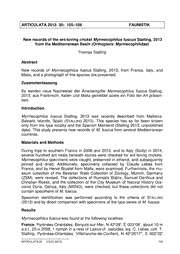
New records of the ant-loving cricket Myrmecophilus fuscus Stalling, 2013 from the Mediterranean Basin (Orthoptera: Myrmecophilidae) PDF
Preview New records of the ant-loving cricket Myrmecophilus fuscus Stalling, 2013 from the Mediterranean Basin (Orthoptera: Myrmecophilidae)
ARTICULATA 2015 30: 105–108 FAUNISTIK New records of the ant-loving cricket Myrmecophilus fuscus Stalling, 2013 from the Mediterranean Basin (Orthoptera: Myrmecophilidae) Thomas Stalling Abstract New records of Myrmecophilus fuscus Stalling, 2013, from France, Italy, and Malta, and a photograph of this species are presented. Zusammenfassung Es werden neue Nachweise der Ameisengrille Myrmecophilus fuscus Stalling, 2013, aus Frankreich, Italien und Malta gemeldet sowie ein Foto der Art präsen- tiert. Introduction Myrmecophilus fuscus Stalling, 2013 was recently described from Mallorca, Balearic Islands, Spain (STALLING 2013). This species has so far been known only from the type locality and the Spanish Mainland (Stalling 2013, unpublished data). This study presents new records of M. fuscus from several Mediterranean countries. Materials and Methods During trips to southern France in 2008 and 2013, and to Italy (Sicily) in 2014, several hundred ant nests beneath stones were checked for ant-loving crickets. Myrmecophilus specimens were caught, preserved in ethanol, and subsequently pinned and dried. Additionally, specimens collected by Claude Lebas from France, and by Hervé Brustel from Malta, were examined. Furthermore, the mu- seum collection of the Bavarian State Collection of Zoology, Munich, Germany (ZSM), were revised. The collections of Rumsaïs Blatrix, Samuel Danflous and Christian Roesti, and the collection of the City Museum of Natural History Gia- como Doria, Genoa, Italy (MSNG), were checked, but these collections did not contain specimens of M. fuscus. Specimen identification was performed according to the criteria of STALLING (2013) and by direct comparison with specimens of the type series of M. fuscus. Results Myrmecophilus fuscus was found at the following localities: France: Pyrénées-Orientales, Banyuls-sur-Mer, N 42°29', E 003°08', about 10 m a.s.l., 20.ix.2008, 1 nymph in a nest of Lasius cf. lasioides, leg. C. Lebas, coll. T. Stalling; Pyrénées-Orientales, Villefranche-de-Conflent, N 42°35'17", E 002°22' ARTICULATA 30 [15.07.2015] 105 19.3", 500 m a.s.l., 14.v.2013, 4 ad. females, 5 ad. males, and 15 female nymphs in nests of Lasius sp. and Pheidole pallidula, leg. & coll. T. Stalling; Pyrénées- Orientales, Port-Vendres, N 42°30'22", E 003°07'26", 20 m a.s.l., 11.v.2013, 1 male nymph and 1 female nymph in nests of Lasius sp., leg. & coll. T. Stalling; Vaucluse, Mornas, N 44°12'30″, E 004°43'56″, 170 m a.s.l., 26.xi.2008, 1 ad. male in a nest of Lasius sp., leg. & coll. T. Stalling; Haute-Corse, Corte, N 42°16' 16", E 009°06'04", about 700 m a.s.l., 06.iv.1990, 1 ad. female in a nest of For- micidae sp., leg. V. Assing, coll. ZSM; and Haute-Corse, Albertacce, N 42°19' 41", E 008°59'04" E, about 900 m a.s.l., 09.iv.1990, 1 ad. female in a nest of Formicidae sp., leg. V. Assing, coll. ZSM. Italy: Messina province (Sicily), Mandanici, N 38°00'47", E 015°18'08", 630 m a.s.l., 16.x.2013, 4 ad. females and 2 ad. males in a nest of Lasius sp., leg. & coll. T. Stalling. Malta: Malta Majjistral, Dingli, Buskett Gardens, N 35°51′, E 014°23′, about 200 m a.s.l., 01.xi.2012, 1 ad. male, leg. H. Brustel, coll. T. Stalling. The species was found in various habitat types, including semi-open oak forest (Villefranche-de-Conflent, France), pine forest (Port-Vendres, France), and semi- open scrub vegetation (Mandanici, Sicily). Discussion The records obtained during this study show that Myrmecophilus fuscus is largely distributed in the Mediterranean Basin. The species was not distinguished from Myrmecophilus acervorum (Panzer, [1799]) before its description in 2013. There- fore, some of the records of M. acervorum from Mediterranean countries that were published prior to the description of M. fuscus probably also belong to M. fuscus, e.g., the records of M. acervorum from Sicily (published by MASSA et al. 2012). The species is presumed to occur in other regions of Italy (notably Sar- dinia) and possibly in northern Africa as well. M. fuscus differs from the other species of the subgenus Myrmecophilus Ber- thold, 1827 from the Western Mediterranean by the following characteristics: Subgenital plate of female clearly emarginated (rounded in M. myrmecophilus (Savi, 1819) and most specimens of M. aequispina Chopard, 1923). M. fuscus has only one type of inclined, distant, relatively long hair-like scales, whereas M. aequispina has two different types of hair-like scales on pro- and mesonotum and tergites (relatively few distant scales and, moreover, many short, closely- fitting scales). The colouration is dark ochreous with pale ochreous posterior margins of pronotum, mesonotum and tergites 1–3 (pale ochreous with no or in- conspicuous pale posterior margins of pronotum, mesonotum, and tergites in M. myrmecophilus and M. aequispina; dark reddish-brown colouration with pale ochreous posterior margins of pronotum and mesonotum in M. acervorum). 106 [15.07.2015] ARTICULATA 30 Figure 1: Myrmecophilus fuscus, male, 16.10.2013, Italy, Sicily, Mandanici. Figure 2: Distribution of Myrmecophilus fuscus. Black dots: new records from France, Italy, and Malta; white dot: locus typicus published by STALLING (2013); grey dots: unpublished records from the Spanish mainland. The map is based on a map from Nzeemin, © GNU Free Documentation License. ARTICULATA 30 [15.07.2015] 107 Acknowledgments Many thanks to Rumsaïs Blatrix (France), Hervé Brustel (France), Samuel Danflous (France), Claude Lebas (France), Calogero Muscarella (Italy), Christian Roesti (Switzerland), the Bavarian State Collection of Zoology, Munich (Germa- ny), and the City Museum of Natural History Giacomo Doria, Genoa (Italy), for providing specimens for examination and detailed information about their find- ings. Author: Thomas Stalling Möndenweg 26 79594 Inzlingen E-Mail: [email protected] References MASSA, B., FONTANA, P., BUZZETTI, F.M., KLEUKERS, R. & BAUDEWIJN, O. (2012): Fauna d' Italia Vol. XLVIII, Orthoptera. - Calderini, 563 pp. STALLING, T. (2013): A new species of ant-loving cricket from Mallorca, Balearic Islands, Spain (Orthoptera: Myrmecophilidae). - Graellsia 69 (2): 153-156. 108 [15.07.2015] ARTICULATA 30
